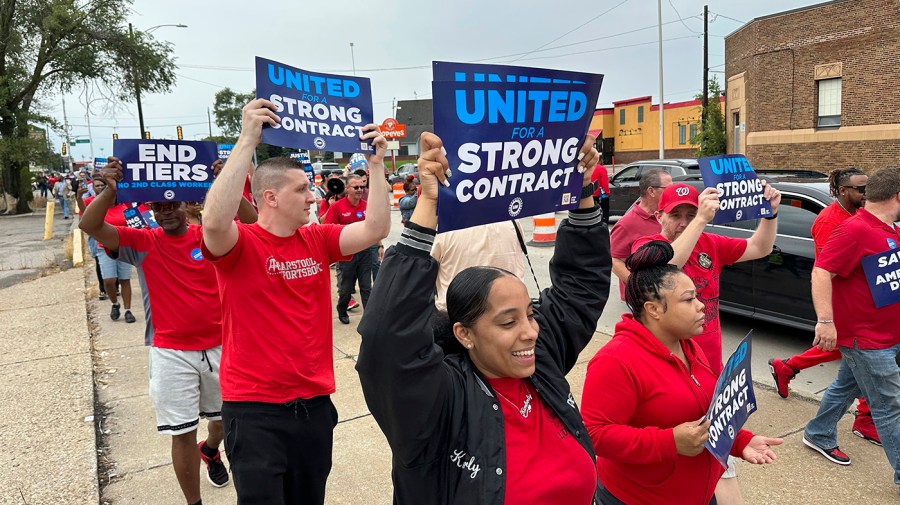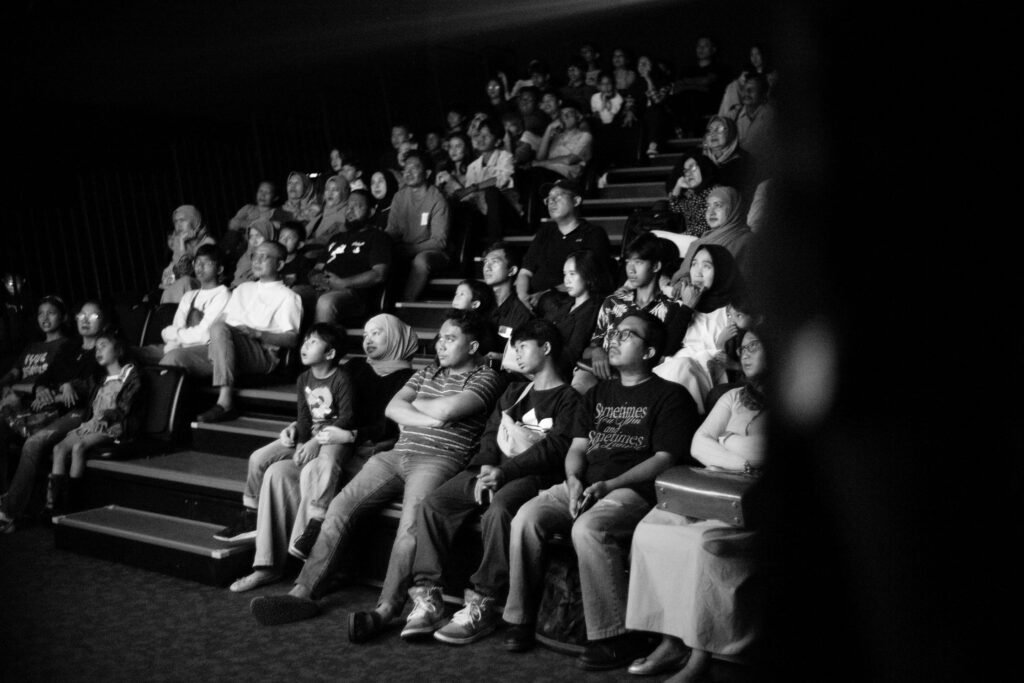Business
Looming auto strike puts Biden’s labor loyalty to the test on August 31, 2023 at 10:00 am Business News | The Hill

A potential strike at the big three automakers in mid-September is about to show whether the “summer of strikes” can carry its momentum into this autumn.
United Auto Workers (UAW) are set to strike Sept. 14 if they don’t reach a deal with Ford, GM and Stellantis, and their endorsement for Biden could prove to be a seal of authenticity on the administration’s pro-labor self-styling.
“We’re focused on winning the best possible contract for our members in 2023, and then we can talk 2024,” the union said in a statement provided to The Hill.
5 big questions about the ‘summer of strikes’
“We want to see a federal government that is actively supporting our fight for economic justice in this green transition. Unfortunately, the Biden Administration is pouring billions into these companies’ pockets with no strings attached. A green transition with trickle-down economics won’t work,” the group said, referring to an economic doctrine associated in the U.S. with the Reagan administration.
The White House has been in touch with the negotiating parties, just as it had been with railroad workers who almost struck last year, as well as with Teamsters who just wrapped a contract negotiation with UPS.
“We’re not going to read out every, every conversation that this President has with parties in these negotiations, but the White House remains in close touch, as we have been in many other, in many of these other discussions with the UAW and the Big Three Automakers,” White House spokesperson Karine Jean-Pierre said Monday.
UPS Teamsters had asked the White House not to get involved in their own dispute, likening the negotiation to a street fight to be avoided by third-parties.
FILE – United Auto Workers members walk in the Labor Day parade in Detroit, Sept. 2, 2019. (AP Photo/Paul Sancya, File)
What does the UAW want?
The UAW is fighting for better pay, working conditions, and a return to defined-benefit pension programs, as opposed to retirement plans that are yoked to market performance. Market-pegged retirement plans became further embedded within the U.S. economy last year with the passage of Secure 2.0 retirement legislation, which included huge perks for wealthy retirees.
A defined-benefit pension program could significantly change the auto industry’s capital structure. How much depends on what exactly is negotiated, as such plans can require companies to keep cash on hand for their employees and their families, as opposed to reinvesting it and returning it to them via returns on stock.
Lawmakers keep a close eye on writers strike with no end in sight
They could also affect how the big three return investments to their own shareholders, as well as the astronomical sums they award to their own executives.
Ford announced a third-quarter dividend of 15 cents per share on the company’s common and Class B stock, the company announced in July.
In a statement provided to The Hill on Wednesday, Stellantis described the status of negotiations as “constructive and collaborative.”
“The discussions between the Company and the UAW’s bargaining team continue to be constructive and collaborative with a focus on reaching a new agreement that balances the concerns of our 43,000 employees with our vision for the future – one that better positions the business to meet the challenges of the U.S. marketplace and secures the future for all of our employees, their families and our company,” Stellantis’ statement says.
FILE – United Auto Workers President Shawn Fain addresses delegates at the union’s 2023 Special Bargaining Convention, Monday, March 27, 2023, in Detroit. The new president of the United Auto Workers union isn’t happy with Detroit’s three automakers. Shawn Fain, who took office in March, listed grievances with Stellantis, General Motors and Ford in a wide-ranging talk Friday, April 21, 2023, with reporters. (AP Photo/Carlos Osorio, File)
Memories of the Great Recession remain fresh
Fresh in the mind of the union, which has been energized by new leadership under the presidency of Shawn Fain, is the 2008 financial crisis, which significantly changed the labor and remuneration structure of the automotive industry.
“They got bailed out. We got sold out,” the union’s statement says. “The Great Recession turned the auto industry upside down. To save it, autoworkers took massive cuts to their wages and benefits. The companies introduced ‘tiers,’ worse pay for the same work.”
“Pensions were eliminated. Post-retirement healthcare vanished for new hires. Jobs were cut. The companies got billions in taxpayer dollars, while auto workers took deep cuts and made life-changing sacrifices to keep the industry alive,” it says.
Teamsters ratify new UPS contract, avoid massive strike
Auto industry profits surged during the recovery of the pandemic as profits contributed to and prolonged inflation, with Ford raising its full-year profitability guidance to between $11 billion and $12 billion in the second quarter.
The company’s free cash flow estimate for the rest of the year was bumped up to between $6.5 billion and $7 billion.
Dealers prep inventory ahead of UAW strike
A UAW strike would interrupt production schedules and order deliveries to dealerships, and some dealers are already preparing.
“Some dealers are starting to plan for the potential of a UAW strike and that is pushing them to the lanes to ensure they have inventory ‘just in case,’” Black Book, an automotive data agency, reported Tuesday.
Price implications in the automotive wholesale market are already starting to surface. For the first time this month, prices didn’t drop by more than 1 percent, according to Black Book data, indicating potential inventory concerns among car salespeople.
White House press secretary Karine Jean-Pierre addresses reporters during the daily briefing at the White House on Friday, July 7, 2023.
Automakers take aim at the ‘green economy’
The auto industry is of strategic importance to the Biden administration after the passage of the Inflation Reduction Act, which included heaps of tax credits for the construction of electric vehicles as part of a “green transition” to make the economy less environmentally destructive.
The legislation included $394 billion in tax credits geared toward energy and the climate, according to management consulting firm McKinsey.
“Some $43 billion in IRA tax credits aim to lower emissions by making [electric vehicles], energy-efficient appliances, rooftop solar panels, geothermal heating, and home batteries more affordable,” the company wrote in analysis of the legislation.
On Monday, the Treasury Department sent a love letter to unions in the form of a new report, arguing that unions are central to the U.S. middle class.
Treasury touts labor unions during ‘summer of strikes’
“The Biden-Harris Administration recognizes the benefits of unions to the middle class and the broader economy and is committed to fulfilling the policy objectives of the [National Labor Relations Act],” the report said.
While unions are seeing a surge in popularity in the U.S., organized labor has been in long-term decline, with union participation rates falling by half since they first started being measured in the early 1980s.
Business, Biden administration, Electric vehicles, Ford Motor Company, General Motors, Inflation Reduction Act, Stellantis, United Auto Workers A potential strike at the big three automakers in mid-September is about to show whether the “summer of strikes” can carry its momentum into this autumn. United Auto Workers (UAW) are set to strike Sept. 14 if they don’t reach a deal with Ford, GM and Stellantis, and their endorsement for Biden could prove to…
Business
Harvard Grads Jobless? How AI & Ghost Jobs Broke Hiring

America’s job market is facing an unprecedented crisis—and nowhere is this more painfully obvious than at Harvard, the world’s gold standard for elite education. A stunning 25% of Harvard’s MBA class of 2025 remains unemployed months after graduation, the highest rate recorded in university history. The Ivy League dream has become a harsh wakeup call, and it’s sending shockwaves across the professional landscape.

Jobless at the Top: Why Graduates Can’t Find Work
For decades, a Harvard diploma was considered a golden ticket. Now, graduates send out hundreds of résumés, often from their parents’ homes, only to get ghosted or auto-rejected by machines. Only 30% of all 2025 graduates nationally have found full-time work in their field, and nearly half feel unprepared for the workforce. “Go to college, get a good job“—that promise is slipping away, even for the smartest and most driven.
Tech’s Iron Grip: ATS and AI Gatekeepers
Applicant tracking systems (ATS) and AI algorithms have become ruthless gatekeepers. If a résumé doesn’t perfectly match the keywords or formatting demanded by the bots, it never reaches human eyes. The age of human connection is gone—now, you’re just a data point to be sorted and discarded.
AI screening has gone beyond basic qualifications. New tools “read” for inferred personality and tone, rejecting candidates for reasons they never see. Worse, up to half of online job listings may be fake—created simply to collect résumés, pad company metrics, or fulfill compliance without ever intending to fill the role.
The Experience Trap: Entry-Level Jobs Require Years
It’s not just Harvard grads who are hurting. Entry-level roles demand years of experience, unpaid internships, and portfolios that resemble a seasoned professional, not a fresh graduate. A bachelor’s degree, once the key to entry, is now just the price of admission. Overqualified candidates compete for underpaid jobs, often just to survive.
One Harvard MBA described applying to 1,000 jobs with no results. Companies, inundated by applications, are now so selective that only those who precisely “game the system” have a shot. This has fundamentally flipped the hiring pyramid: enormous demand for experience, shrinking chances for new entrants, and a brutal gauntlet for anyone not perfectly groomed by internships and coaching.
Burnout Before Day One
The cost is more than financial—mental health and optimism are collapsing among the newest generation of workers. Many come out of elite programs and immediately end up in jobs that don’t require degrees, or take positions far below their qualifications just to pay the bills. There’s a sense of burnout before careers even begin, trapping talent in a cycle of exhaustion, frustration, and disillusionment.
Cultural Collapse: From Relationships to Algorithms
What’s really broken? The culture of hiring itself. Companies have traded trust, mentorship, and relationships for metrics, optimizations, and cost-cutting. Managers no longer hire on potential—they rely on machines, rankings, and personality tests that filter out individuality and reward those who play the algorithmic game best.
AI has automated the very entry-level work that used to build careers—research, drafting, and analysis—and erased the first rung of the professional ladder for thousands of new graduates. The result is a workforce filled with people who know how to pass tests, not necessarily solve problems or drive innovation.
The Ghost Job Phenomenon
Up to half of all listings for entry-level jobs may be “ghost jobs”—positions posted online for optics, compliance, or future needs, but never intended for real hiring. This means millions of job seekers spend hours on applications destined for digital purgatory, further fueling exhaustion and cynicism.
Not Lazy—Just Locked Out
Despite the headlines, the new class of unemployed graduates is not lazy or entitled—they are overqualified, underleveraged, and battered by a broken process. Harvard’s brand means less to AI and ATS systems than the right keyword or résumé format. Human judgment has been sidelined; individuality is filtered out.

What’s Next? Back to Human Connection
Unless companies rediscover the value of human potential, mentorship, and relationships, the job search will remain a brutal numbers game—one that even the “best and brightest” struggle to win. The current system doesn’t just hurt workers—it holds companies back from hiring bold, creative talent who don’t fit perfect digital boxes.
Key Facts:
- 25% of Harvard MBAs unemployed, highest on record
- Only 30% of 2025 grads nationwide have jobs in their field
- Nearly half of grads feel unprepared for real work
- Up to 50% of entry-level listings are “ghost jobs”
- AI and ATS have replaced human judgment at most companies
If you’ve felt this struggle—or see it happening around you—share your story in the comments. And make sure to subscribe for more deep dives on the reality of today’s economy and job market.
This is not just a Harvard problem. It’s a sign that America’s job engine is running on empty, and it’s time to reboot—before another generation is locked out.
Business
Why 9 Million Americans Have Left

The Growing American Exodus
Nearly 9 million Americans now live outside the United States—a number that rivals the population of several states and signals a profound shift in how people view the American dream. This mass migration isn’t confined to retirees or the wealthy. Thanks to remote work, digital nomad visas, and mounting pressures at home, young professionals, families, and business owners are increasingly joining the ranks of expats.

Rising Costs and Shrinking Wallets
Living in the US has become increasingly expensive. Weekly grocery bills topping $300 are not uncommon, and everyday items like coffee and beef have surged in price over the last year. Rent, utilities, and other essentials also continue to climb, leaving many Americans to cut meals or put off purchases just to make ends meet. In contrast, life in countries like Mexico or Costa Rica often costs just 50–60% of what it does in the US—without sacrificing comfort or quality.
Health Care Concerns Drive Migration
America’s health care system is a major trigger for relocation. Despite the fact that the US spends more per person on health care than any other country, millions struggle to access affordable treatment. Over half of Americans admit to delaying medical care due to cost, with households earning below $40,000 seeing this rate jump to 63%. Many expats point to countries such as Spain or Thailand, where health care is both affordable and accessible, as a major draw.

Seeking Safety Abroad
Public safety issues—especially violent crime and gun-related incidents—have made many Americans feel unsafe, even in their own communities. The 2024 Global Peace Index documents a decline in North America’s safety ratings, while families in major cities often prioritize teaching their children to avoid gun violence over simple street safety. In many overseas destinations, newly arrived American families report a significant improvement in their sense of security and peace of mind.
Tax Burdens and Bureaucracy
US tax laws extend abroad, requiring expats to file annual returns and comply with complicated rules through acts such as FATCA. For some, the burden of global tax compliance is so great that thousands relinquish their US citizenship each year simply to escape the paperwork and scrutiny.
The Digital Nomad Revolution
Remote work has unlocked new pathways for Americans. Over a quarter of all paid workdays in the US are now fully remote, and more than 40 countries offer digital nomad visas for foreign professionals. Many Americans are leveraging this opportunity to maintain their US incomes while cutting costs and upgrading their quality of life abroad.

Conclusion: Redefining the Dream
The mass departure of nearly 9 million Americans reveals deep cracks in what was once considered the land of opportunity. Escalating costs, inaccessible healthcare, safety concerns, and relentless bureaucracy have spurred a global search for better options. For millions, the modern American dream is no longer tied to a white-picket fence, but found in newfound freedom beyond America’s borders.
Business
Will Theaters Crush Streaming in Hollywood’s Next Act?

Hollywood is bracing for a pivotal comeback, and for movie lovers, it’s the kind of shake-up that could redefine the very culture of cinema. With the freshly merged Paramount-Skydance shaking up its strategy, CEO David Ellison’s announcement doesn’t just signal a change—it reignites the passion for moviegoing that built the magic of Hollywood in the first place.

Theatrical Experience Roars Back
Fans and insiders alike have felt the itch for more event movies. For years, streaming promised endless options, but fragmented attention left many longing for communal spectacle. Now, with Paramount-Skydance tripling its film output for the big screen, it’s clear: studio leaders believe there’s no substitute for the lights, the hush before the opening credits, and the collective thrill of reacting to Hollywood’s latest blockbusters. Ellison’s pivot away from streaming exclusives taps deep into what unites cinephiles—the lived experience of cinema as art and event, not just content.
Industry Pulse: From Crisis to Renaissance
On the financial front, the numbers are as electrifying as any plot twist. After years of doubt, the box office is roaring. AMC, the world’s largest theater chain, reports a staggering 26% spike in moviegoer attendance and 36% revenue growth in Q2 2025. That kind of momentum hasn’t been seen since the heyday of summer tentpoles—and it’s not just about more tickets sold. AMC’s strategy—premium screens, with IMAX and Dolby Cinema, curated concessions, and branded collectibles—has turned every new release into an event, driving per-customer profits up nearly 50% compared to pre-pandemic norms.
Blockbusters Lead the Culture
Forget the gloom of endless streaming drops; when films like Top Gun: Maverick, Mission: Impossible, Minecraft, and surprise hits like Weapons and Freakier Friday draw crowds, the industry—and movie fans—sit up and take notice. Movie-themed collectibles and concession innovations, from Barbie’s iconic pink car popcorn holders to anniversary tie-ins, have made each screening a moment worth remembering, blending nostalgia and discovery. The focus: high-impact, shared audience experiences that streaming can’t replicate.
Streaming’s Limits and Studio Strategy
Yes, streaming is still surging, but the tide may be turning. The biggest franchises, and the biggest cultural events, happen when audiences come together for a theatrical release. Paramount-Skydance’s shift signals to rivals that premium storytelling and box office spectacle are again at the center of Hollywood value creation. The result is not just higher profits for exhibitors like AMC, but a rebirth of movie-going as the ultimate destination for fans hungry for connection and cinematic adventure.

Future Forecast: Culture, Community, and Blockbuster Dreams
As PwC and others warn that box office totals may take years to fully catch up, movie lovers and industry leaders alike are betting that exclusive theatrical runs, enhanced viewing experiences, and fan-driven engagement are the ingredients for long-term recovery—and a new golden age. The Paramount-Skydance play is more than a business move; it’s a rallying cry for the art of the theatrical event. Expect more big bets, more surprises, and—finally—a long-overdue renaissance for the silver screen.
For those who believe in the power of cinema, it’s a thrilling second act—and the best seat in the house might be front and center once again.

 Business3 weeks ago
Business3 weeks agoWhy Are Influencers Getting $7K to Post About Israel?

 Entertainment3 weeks ago
Entertainment3 weeks agoKeith Urban and Nicole Kidman Split After 20 Years as Actress Files for Divorce

 Entertainment3 weeks ago
Entertainment3 weeks agoTilly Norwood’s Rise Stirs Controversy

 News3 weeks ago
News3 weeks agoHow a Government Shutdown Could Hit Your Life and Wallet

 Entertainment4 weeks ago
Entertainment4 weeks agoWhy Did Dakarai Trash His NBA Letters?

 Business3 weeks ago
Business3 weeks agoOverqualified? Great, Now Prove You’ll Work for Free and Love It!

 Entertainment3 weeks ago
Entertainment3 weeks agoJudge Sends Diddy to Prison for 50 Months

 News2 weeks ago
News2 weeks agoHow Digital ID Is Becoming Everyone’s New Gatekeeper






























